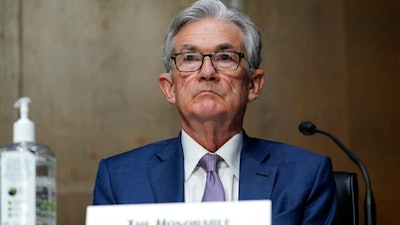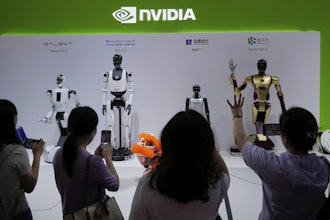
WASHINGTON (AP) — The Federal Reserve signaled Wednesday that it may act sooner than previously planned to start dialing back the low-interest-rate policies that have helped fuel a swift rebound from the pandemic recession but have also coincided with rising inflation.
The Fed's policymakers forecast that they would raise their benchmark short-term rate — which affects many consumer and business loans, including mortgages and credit cards — twice by late 2023. They had previously estimated that no rate hike would occur before 2024.
At a news conference, Chair Jerome Powell said the Fed's policymaking committee also began discussing when to reduce its monthly bond purchases. But Powell made clear that the Fed has yet to decide when it will do so. The purchases, which consist of $120 billion in Treasury and mortgage bonds, are intended to keep longer-term rates low to encourage borrowing.
The Fed has made clear that its first step in slowing its support for the economy will be to pare its bond purchases — and that it would begin to raise rates only sometime after that. Its key rate has been pinned near zero since March 2020.
The central bank's new forecast for rate hikes starting in 2023 reflects an economy that's achieving faster progress than was expected earlier this year.
At the same time, Powell sought Wednesday to dispel any concerns that the Fed might be in a hurry to withdraw its economic support by making borrowing more expensive. The economy, he said, still hasn't improved enough to reduce the pace of the monthly bond purchases, which the Fed has said it intends to continue until “substantial further progress” has been made toward its employment and inflation goals.
“We are a ways away from substantial further progress, we think,” Powell said at his news conference. "But we are making progress.”
Soon after the Fed issued its statement Wednesday, U.S. stocks fell further from their record highs, and bond yields rose. The yield on the 10-year Treasury note rose from 1.48% to 1.55%.
Sung Won Sohn, an economist at Loyola Marymount University in Los Angeles, suggested that the markets' initially negative reaction to the Fed's statement might have caused Powell to take a more dovish tone at his news conference. (“Doves,” in Fed parlance, typically focus on the Fed’s mandate to maximize employment and worry less about inflation. “Hawks,” by contrast, tend to concern themselves more with the need to prevent high inflation.)
“We got two different messages from the Fed today,” Sohn said. “The interest rate projections were a bit more hawkish than the market expected."
But at his news conference, Sohn said, Powell “emphasized that the economy is still not where it should be, especially in terms of unemployment .... and the Fed still thinks the economy needs stimulus from the central bank.”
Still, Powell also sketched an overall optimistic picture in his remarks Wednesday. The inflation spikes of the past two months, he said, will likely prove temporary, and hiring should accelerate through summer and into the fall as COVID-19 recedes further with increased vaccinations. That will allow schools and day care centers to reopen, which will enable more parents to work, while supplemental federal aid for the jobless ends.
“There is every reason,” Powell said, “to think that we will (soon) be in a labor market with very attractive numbers, with low unemployment, high participation and rising wages across the spectrum.”
His comments suggested that the Fed chair isn't concerned that hiring this spring, while solid, has fallen shy of forecasts. Powell had said in early spring that he would want to see a “string” of hiring reports showing about 1 million added jobs each month. The job market has yet to reach that total in any month this year, though employers have posted a record-high number of open jobs
At the same time, inflation has shot up much faster than the Fed's policymakers had forecast in March. Inflation jumped to 5% in May compared with a year earlier — the largest 12-month spike since 2008.
The increase was driven partly by a huge rise in used car prices, which have soared as shortages of semiconductors have slowed vehicle production. Sharply higher prices for car rentals, airline tickets, and hotel rooms were also major factors, reflecting pent-up demand as consumers shift away from the large goods purchases many of them had made while stuck at home to spending on services.
Powell stuck with his long-standing view that those spikes will have only a temporary impact.
“The prices that are driving higher inflation are from categories that are being directly affected by the recovery from the pandemic and the reopening of the economy,” he said. “Prices that have moved up really quickly because of the shortages and bottlenecks and the like, they should stop going up. And at some point, they in some cases should actually go down.”
The central bank on Wednesday raised its forecast for inflation to 3.4% by the end of this year, from 2.4% in its previous projection in March. Yet the officials foresee price increases remaining tame in the following two years.
Fed officials also expect the economy to grow 7% this year, which would be the fastest calendar-year expansion since 1984. They project that growth will slow after that, to 3.3% in 2022 and 2.4% in 2023.
Economists generally expect the Fed to continue discussing tapering its bond purchases and then — by late August or September — to outline specifically how and when it would begin. That would set the stage for a reduction in bond purchases to actually begin near the end of this year or in early 2022.
Another key consideration for the Fed is whether inflation persists long enough to affect the public’s behavior. If Americans begin to expect price increases, those expectations can trigger a self-fulfilling cycle as workers demand higher wages, which, in turn, can lead their employers to keep raising prices to offset their higher labor costs.
Powell said that measures of longer-term inflation expectations have increased in recent months, after falling at the outset of the pandemic. But they mostly remain in a range consistent with the Fed's 2% inflation target.
“It's gratifying to see them having moved up off of their pandemic lows,” he said.






















